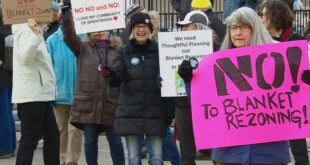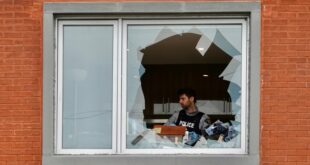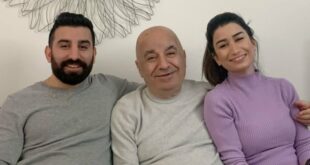Jury lays out 4 recommendations for Saskatoon police, RCMP as coroner’s inquest ends.

WARNING: Some content may be distressing to readers.
After about six hours of deliberations, the jury at a Saskatchewan corner’s inquest into the death of Myles Sanderson has found he died of an accidental acute cocaine toxicity.
Their findings, delivered Thursday evening, follow a nearly week-long inquest in Saskatoon into what led to the death of Sanderson, 32.
Sanderson died on Sept. 7, 2022, three days after he killed 11 people on James Smith Cree Nation and the nearby village of Weldon, Sask.
He went into medical distress when he was arrested, and was declared dead at the Royal University Hospital in Saskatoon at 4:39 p.m. CST, about an hour after his arrest.
Earlier this week, the inquest heard from Saskatchewan’s chief forensic pathologist that Sanderson had died of “acute cocaine overdose,” and that his arrest by the RCMP did not cause or contribute to his death.
Jurors at the inquest also provided four recommendations for police services, including one that the Saskatoon Police Service consider establishing a dedicated team tasked with arresting individuals who are subject to outstanding warrants.
The three other recommendations were directed to the RCMP:
- Consider implementing mandatory enhanced driver training, including a specific tactic used in pursuits to force another vehicle to abruptly turn.
- Consider a policy review in of criteria in high-speed pursuits in the interest of the safety of all involved.
- Consider additional training in the form of enhanced extraction techniques for arrest takedowns.
Eddie Head, Sanderson’s uncle, said the inquest brought closure to the community and his family.
“What was the last days of his life? Where he was, what did he do?” said Head, who had standing at the inquest, meaning he could ask questions of the witnesses on behalf of Sanderson’s family.

He still wonders what Sanderson did between the killings on Sept. 4 and his arrest on Sept. 7.
Inquest testimony confirmed some reported sightings of Sanderson, and that he was stealing from a home near Wakaw and camping nearby, but did not delve into a specific timeline.
Had a plan: forensic psychologist
The jury heard from the last two inquest witnesses Thursday morning.
Forensic psychologist Dr. Matthew Logan testified that Sanderson was found to be “mission-oriented” in his killings and had developed somewhat of a plan before he killed 10 people in his home community of James Smith Cree Nation on and one person in Weldon.
At the time of his arrest, Sanderson was likely on his way to Saskatoon to kill his former common-law partner, Logan said.
Sanderson “pumped himself up with cocaine, stole a vehicle and moved toward other potential targets,” Logan said, quoting from his report.
The psychologist had never met Sanderson, but co-authored a post-mortem behavioural analysis based on his investigation.
Logan said Sanderson targeted people who he felt had wronged him and those connected with the Terror Squad gang, describing him as a mission-oriented offender.
He said those types of offenders typically do not kill people who aren’t their specific targets — like the woman whose truck Sanderson stole near Wakaw, Sask., on Sept. 7 — unless they get in their way.

Jurors at Myles Sanderson inquest hear from officer who forced killer’s stolen truck into ditch
Constable Heidi Marshall described chasing Myles Sanderson into oncoming traffic on a major Saskatchewan highway and the decision she made that ended the chase. Sanderson killed 11 people at James Smith Cree Nation and the neighbouring village of Weldon in September 2022. CBC’s Dan Zakreski has the details.
After stealing the truck, Sanderson led police into oncoming traffic southbound on Highway 11, toward Saskatoon, as they chased after him.
While he could have been searching for refuge with his father in Saskatoon, Logan believes Sanderson was on his way to kill Vanessa Burns, his former common-law partner and the mother of his children.
Logan testified that Sanderson’s recent violence toward Burns likely triggered his plan to massacre people at James Smith Cree Nation.
As he drove into oncoming traffic on Highway 11 at breakneck speeds, forcing dozens of vehicles to the shoulder or the ditch, Sanderson was ambivalent to death, Logan testified.
“It’s really a voluntary self-killing where you’re doing so knowingly, recklessly but not purposefully,” Logan said.
Sanderson showed severe psychopathic traits, Logan testified. Compared to other inmates scored at Canadian institutions, he ranked in the 94th percentile.
Delving into Sanderson’s past
Logan noted a report from the Saskatchewan Penitentiary that said Sanderson had thought of suicide.
He testified that he believes Sanderson likely didn’t mean to overdose on cocaine — referencing the testimony of the forensic pathologist given on Tuesday that marked an overdose as his cause of death — but that he could have taken the substance with reckless regard.
Logan’s behavioural analysis included examining photos of the crime scenes, Sanderson’s past and interviews with family members of those killed and others impacted.
Coroner’s counsel Tim Hawryluk said the behavioural analysis report Logan co-authored is an “extremely rare” request among public inquests.
Logan testified that Sanderson’s childhood was “rife with abuse and instability.” He also started using drugs when he was 13 and, in recent years, used cocaine “considerably.”
Week-long inquest
The inquest also heard from the physician, Dr. William Papenfus, who called Sanderson’s time of death at Royal University Hospital at 4:39 p.m. CST on Sept. 7, 2022.
He testified that when Sanderson arrived at the hospital — while flatlining for the journey from the scene off Highway 11 between Rosthern and Hague, Sask. — a trauma room was waiting for him.
Papenfus said doctors continued life-saving measures.
Doctors were told Sanderson may have ingested some sort of white powder and that he had rapidly deteriorated from an excited state before his cardiac arrest. He said doctors confirmed with an ultrasound that Sanderson had no heart activity.
Since Monday, jurors heard testimony from Saskatchewan Mounties recounting the harrowing police pursuit, paramedics who testified about their life-saving efforts, and opinions from a forensic pathologist and toxicologist.
ABOUT THE AUTHOR

Reporter
Dayne Patterson is a reporter for CBC News in Saskatchewan and is based in Saskatoon. He has a master’s degree in journalism with an interest in data reporting and Indigenous affairs. Reach him at dayne.patterson@cbc.ca.
*****
Credit belongs to : www.cbc.ca
 Atin Ito First Filipino Community Newspaper in Ontario
Atin Ito First Filipino Community Newspaper in Ontario






